Comparison of Five Models for Estimating the Water Retention Service of a Typical Alpine Wetland Region in the Qinghai–Tibetan Plateau
Abstract
:1. Introduction
2. Materials and Methods
2.1. Study Area
2.2. Analysis Framework for Comparing the Water Retention Models
2.3. Data Source and Processing
2.4. Description of Selected Models
2.4.1. InVEST Model
2.4.2. Precipitation Storage Model (PRS Model)
2.4.3. Water Balance Model I (WAB I Model)
| Data | Spatial Resolution | Temporal Resolution | Units | Data Source |
|---|---|---|---|---|
| Rivers | 1:1,000,000 | 2019 | -- | National Geomatics Center of China (http://www.ngcc.cn; accessed on 15 September 2021) |
| Soil texture/depth | 1 km | -- | cm | China Soil Map-Based Harmonized World Soil Database (v1.1) (http://www.ncdc.ac.cn; accessed on 15 September 2021) |
| Temperature (T) | 1 km | 1980–2018, monthly | °C | The National Meteorological Information Center of China (http://data.cma.cn/en; accessed on 20 September 2021) |
| Precipitation (P) | 1 km | 1980–2018, monthly | mm | |
| Potential evapotranspiration (PET) | 1 km | 1980–2018, monthly | mm | |
| Evapotranspiration (ET) | 1 km | 2000–2018, 10 days | mm | [39] (https://www.sciencedirect.com/; accessed on 30 October 2021) |
| Net primary productivity (NPP) | 250 m | 2000–2015, monthly | 0.01 g/cm2 | Institute of Remote Sensing and Digital Earth Chinese Academy of Sciences (http://eds.ceode.ac.cn/; accessed on 15 October 2021) |
| Fractional vegetation cover (FVC) | 250 m | 2000–2015, monthly | —— | |
| Gross Domestic Product (GDP) | 1 km | 2000–2015, yearly | Ten thousand yuan/km2 | Resource and Environmental Science and Data Center (http://www.resdc.cn/;accessed on 15 October 2021) |
| Population density (POP) | 1 km | 2000–2015, yearly | People/km2 |
2.4.4. Water Balance Model II (WAB II Model)
2.4.5. NPP-Based Surrogate Model (NBS Model)
2.5. Analysis of Climate Change Trends
2.6. Analysis of WR Service Change and Drivers
2.6.1. Quantification of WR Values and Their Changes
2.6.2. Determination of Land Use Attributes and Changes
| Model | Types | Spatial Scale | Temporal Scale | Advantages and Disadvantages | Reference |
|---|---|---|---|---|---|
| InVEST model | Water balance-based | Watershed | Year |
| [14,15,21] |
| PRS model | Process-based | All scales | All scales |
| [17,26,41] |
| WAB I model | Water balance-based | All scales | All scales |
| [38] |
| WAB II model | Water balance-based | All scales | All scales |
| [3,19] |
| NBS model | Surrogate biophysical indicators-based | Regional scale | Year |
| [9,10] |
2.6.3. Exploration of Factors Influencing WR Service
3. Results
3.1. Land Use Change from 2000 to 2015
3.2. Climate Change Trends
3.3. Spatial Pattern of WR Service
3.4. Temporal Change in WR Service
3.5. The Driving Factors for WR Service Change
3.5.1. Influence of Climatic Factors on the WR Service
3.5.2. Influence of Socioeconomic Factors on WR Service
4. Discussion
4.1. Model Uncertainty and Applicability
4.2. Spatial–Temporal Patterns of WR Service
4.3. Driving Forces of WR Service
5. Conclusions
Supplementary Materials
Author Contributions
Funding
Data Availability Statement
Acknowledgments
Conflicts of Interest
References
- Millennium Ecosystem Assessment. Ecosystems and Human Well-Being: Synthesis; Island Press: Washington, DC, USA, 2005. [Google Scholar]
- Brauman, K.A.; Daily, G.C.; Duarte, T.K.; Mooney, H.A. The nature and value of ecosystem services: An overview highlighting hydrologic services. Annu. Rev. Environ. Resour. 2007, 32, 67–98. [Google Scholar] [CrossRef]
- Ouyang, Z.Y.; Zheng, H.; Xiao, Y.; Polasky, S.; Liu, J.G.; Xu, W.H.; Wang, Q.; Zhang, L.; Xiao, Y.; Rao, E.M.; et al. Improvements in ecosystem services from investments in natural capital. Science 2016, 352, 1455–1459. [Google Scholar] [CrossRef] [PubMed]
- Lü, Y.H.; Hu, J.; Sun, F.X.; Zhang, L.W. Water retention and hydrological regulation: Harmony but not the same in terrestrial hydrological ecosystem services. Acta Ecol. Sin. 2015, 35, 5191–5196. (In Chinese) [Google Scholar] [CrossRef]
- Sun, F.X.; Lyu, Y.H.; Fu, B.J.; Hu, J. Hydrological services by mountain ecosystems in Qilian Mountain of China: A review. Chin. Geogr. Sci. 2016, 26, 174–187. [Google Scholar] [CrossRef] [Green Version]
- Leng, X.J.; Feng, X.M.; Fu, B.J.; Shi, Q.D.; Ye, H.P.; Zhang, Y. Asian water towers’ are not a sustainable solution to the downstream water crisis. Sci. Total Environ. 2023, 856, 159237. [Google Scholar] [CrossRef]
- Piao, S.L.; Ciais, P.; Huang, Y.; Shen, Z.H.; Peng, S.S.; Li, J.S.; Zhou, L.P.; Liu, H.Y.; Ma, Y.C.; Ding, Y.H.; et al. The impacts of climate change on water resources and agriculture in China. Nature 2010, 467, 43–51. [Google Scholar] [CrossRef]
- Xiao, Y.; Ouyang, Z.Y. Spatial-temporal Patterns and Driving Forces of Water Retention Service in China. Chin. Geogr. Sci. 2019, 29, 100–111. [Google Scholar] [CrossRef] [Green Version]
- Zhang, L.W.; Lü, Y.H.; Fu, B.J.; Dong, Z.B.; Zeng, Y.; Wu, B.F. Mapping ecosystem services for China’s ecoregions with a biophysical surrogate approach. Landsc. Urban Plan. 2017, 161, 22–31. [Google Scholar] [CrossRef]
- Zheng, H.B.; Zhang, L.W.; Wang, P.T.; Li, Y.J. The NPP-Based Composite Indicator for Assessing the Variations of Water Provision Services at the National Scale. Water 2019, 11, 1628. [Google Scholar] [CrossRef] [Green Version]
- Su, C.H.; Dong, M.; Fu, B.J.; Liu, G.H. Scale effects of sediment retention, water yield, and net primary production: A case-study of the Chinese Loess Plateau. Land Degrad. Dev. 2020, 31, 1408–1421. [Google Scholar] [CrossRef]
- Immerzeel, W.W.; Lutz, A.F.; Andrade, M.; Bahl, A.; Biemans, H.; Bolch, T.; Hyde, S.; Brumby, S.; Davies, B.J.; Elmore, A.C.; et al. Importance and vulnerability of the world’s water towers. Nature 2020, 577, 364–369. [Google Scholar] [CrossRef] [PubMed]
- Yao, T.D.; Bolch, T.; Chen, D.L.; Gao, J.; Immerzeel, W.; Piao, S.L.; Su, F.G.; Thompson, L.; Wada, Y.; Wang, L.; et al. The imbalance of the Asian water tower. Nat. Rev. Earth Environ. 2022, 3, 1–15. [Google Scholar] [CrossRef]
- Wang, X.F.; Chu, B.Y.; Feng, X.M.; Li, Y.H.; Fu, B.J.; Liu, S.R.; Jin, J.M. Spatiotemporal variation and driving factors of water yield services on the Qingzang Plateau. Geogr. Sustain. 2021, 2, 31–39. [Google Scholar] [CrossRef]
- Wang, Y.F.; Ye, A.Z.; Peng, D.Z.; Miao, C.Y.; Di, Z.H.; Gong, W. Spatiotemporal variations in water conservation function of the Tibetan Plateau under climate change based on InVEST model. J. Hydrol. Reg. Stud. 2022, 41, 101064. [Google Scholar] [CrossRef]
- Pan, Y.; Wu, J.X.; Xu, Z.R. Analysis of the tradeoffs between provisioning and regulating services from the perspective of varied share of net primary production in an alpine grassland ecosystem. Ecol. Complex. 2014, 17, 79–86. [Google Scholar] [CrossRef]
- Qian, D.W.; Du, Y.G.; Li, Q.; Guo, X.W.; Cao, G.M. Alpine grassland management based on ecosystem service relationships on the southern slopes of the Qilian Mountains, China. J. Environ. Manag. 2021, 288, 112447. [Google Scholar] [CrossRef]
- Hua, T.; Zhao, W.W.; Cherubini, F.; Hu, X.P.; Pereira, P. Sensitivity and future exposure of ecosystem services to climate change on the Tibetan Plateau of China. Landsc. Ecol. 2021, 36, 3451–3471. [Google Scholar] [CrossRef]
- Lin, Z.Y.; Xiao, Y.; Ouyang, Z.Y. Assessment of ecological importance of the Qinghai-Tibet Plateau based on ecosystem service flows. J. Mt. Sci. 2021, 18, 1725–1736. [Google Scholar] [CrossRef]
- Liu, Y.X.; Lü, Y.H.; Jiang, W.; Zhao, M.Y. Mapping critical natural capital at a regional scale: Spatiotemporal variations and the effectiveness of priority conservation. Environ. Res. Lett. 2020, 15, 124025. [Google Scholar] [CrossRef]
- Dennedy-Frank, P.J.; Muenich, R.; Chaubey, I.; Ziv, G. Comparing two tools for ecosystem service assessments regarding water resources decisions. J. Environ. Manag. 2016, 177, 331–340. [Google Scholar] [CrossRef]
- Cong, W.C.; Sun, X.Y.; Guo, H.W.; Shan, R.F. Comparison of the SWAT and InVEST models to determine hydrological ecosystem service spatial patterns, priorities and trade-offs in a complex basin. Ecol. Indic. 2020, 112, 106089. [Google Scholar] [CrossRef]
- Temmink, R.J.M.; Lamers, L.P.M.; Angelini, C.; Bouma, T.J.; Fritz, C.; van de Koppel, J.; Lexmond, R.; Rietkerk, M.; Silliman, B.R.; Joosten, H.; et al. Recovering wetland biogeomorphic feedbacks to restore the world’s biotic carbon hotspots. Science 2022, 376, 6593. [Google Scholar] [CrossRef] [PubMed]
- Yu, Z.C.; Joos, F.; Bauska, T.K.; Stocker, B.D.; Fischer, H.; Loisel, J.; Brovkin, V.; Hugelius, G.; Nehrbass-Ahles, C.; Kleinen, T.; et al. No support for carbon storage of >1000 GtC in northern peatlands. Nat. Geosci. 2021, 14, 465–467. [Google Scholar] [CrossRef]
- Li, B.Q.; Yu, Z.B.; Liang, Z.M.; Song, K.C.; Li, H.X.; Wang, Y.; Zhang, W.J.; Acharya, K. Effects of Climate Variations and Human Activities on Runoff in the Zoige Alpine Wetland in the Eastern Edge of the Tibetan Plateau. J. Hydrol. Eng. 2014, 19, 1026–1035. [Google Scholar] [CrossRef]
- Li, Z.W.; Wang, Z.Y.; Brierley, G.; Nicoll, T.; Pan, B.Z.; Li, Y.F. Shrinkage of the Ruoergai Swamp and changes to landscape connectivity, Qinghai-Tibet Plateau. CATENA 2015, 126, 155–163. [Google Scholar] [CrossRef]
- Qin, G.H.; Li, H.X.; Zhou, Z.J.; Song, K.C.; Zhang, L. Hydrologic Variations and Stochastic Modeling of Runoff in Zoige Wetland in the Eastern Tibetan Plateau. Adv. Meteorol. 2015, 2015, 529354. [Google Scholar] [CrossRef] [Green Version]
- Xi, Y.; Peng, S.S.; Ciais, P.; Chen, Y.H. Future impacts of climate change on inland Ramsar wetlands. Nat. Clim. Chang. 2021, 11, 45–51. [Google Scholar] [CrossRef]
- Yuan, Y.; Zhang, L.; Cui, L.L. Spatiotemporal variations of water conservation capacity in Ruoergai Plateau. Chin. J. Ecol. 2020, 39, 2713–2723. (In Chinese) [Google Scholar]
- Chen, H.; Wu, N.; Gao, Y.; Wang, Y.; Luo, P.; Tian, J. Spatial variations on methane emissions from Zoige alpine wetlands of Southwest China. Sci. Total Environ. 2009, 407, 1097–1104. [Google Scholar] [CrossRef]
- Cui, Q.; Wang, X.; Li, C.H.; Cai, Y.P.; Liu, Q.; Li, R. Ecosystem service value analysis of CO2 management based on land use change of Zoige alpine peat wetland, Tibetan Plateau. Ecol. Eng. 2015, 76, 158–165. [Google Scholar] [CrossRef]
- Li, J.C.; Wang, W.L.; Hu, G.Y.; Wei, Z.H. Changes in ecosystem service values in Zoige Plateau, China. Agric. Ecosyst. Environ. 2010, 139, 766–770. [Google Scholar] [CrossRef]
- Zhang, X.Y.; Lu, X.G. Multiple criteria evaluation of ecosystem services for the Ruoergai Plateau Marshes in southwest China. Ecol. Econ. 2010, 69, 1463–1470. [Google Scholar] [CrossRef]
- Fu, B.J.; Wang, S.; Su, C.H.; Forsius, M. Linking ecosystem processes and ecosystem services. Curr. Opin. Environ. Sustain. 2013, 5, 4–10. [Google Scholar] [CrossRef]
- Lü, Y.H.; Hu, J.; Fu, B.J.; Harris, P.; Wu, L.H.; Tong, X.L.; Bai, Y.F.; Comber, A.J. A framework for the regional critical zone classification: The case of the Chinese Loess Plateau. Natl. Sci. Rev. 2019, 6, 14–18. [Google Scholar] [CrossRef] [PubMed]
- Xu, X.L.; Liu, W. The global distribution of Earth’s critical zone and its controlling factors. Geophys. Res. Lett. 2017, 44, 3201–3208. [Google Scholar] [CrossRef]
- Allen, R.G.; Pereira, L.S.; Raes, D.; Smith, M. Crop Evapotranspiration: Guidelines for Computing Crop Water Requirements—FAO Irrigation and Drainage Paper 56; Food and Agriculture Organization: Rome, Italy, 1998. [Google Scholar]
- Wei, H.J.; Fan, W.G.; Ding, Z.Y.; Weng, B.Q.; Xing, K.X.; Wang, X.C.; Lu, N.C.; Ulgiati, S.; Dong, X.B. Ecosystem Services and Ecological Restoration in the Northern Shaanxi Loess Plateau, China, in Relation to Climate Fluc-tuation and Investments in Natural Capital. Sustainability 2017, 9, 199. [Google Scholar] [CrossRef] [Green Version]
- Yin, L.C.; Tao, F.L.; Chen, Y.; Liu, F.S.; Hu, J. Improving terrestrial evapotranspiration estimation across China during 2000–2018 with machine learning methods. J. Hydrol. 2021, 600, 126538. [Google Scholar] [CrossRef]
- Di, X.H.; Hou, X.Y.; Wang, Y.D.; Wu, L. Spatial-temporal characteristics of land use intensity of coastal zone in China during 2000–2010. Chin. Geogr. Sci. 2015, 25, 51–61. [Google Scholar] [CrossRef]
- Qin, Y.; Yang, D.W.; Gao, B.; Wang, T.H.; Chen, J.S.; Chen, Y.; Wang, Y.H.; Zheng, G.H. Impacts of climate warming on the frozen ground and eco-hydrology in the Yellow River source region, China. Sci. Total Environ. 2017, 605, 830–841. [Google Scholar] [CrossRef] [Green Version]
- Yu, X.X.; Zhou, B.; Lü, X.Z.; Yang, Z.G. Evaluation of water conservation function in mountain forest areas of Beijing based on InVEST Model. Sci. Silvae. Sin. 2012, 48, 1–5. (In Chinese) [Google Scholar]
- He, L.; Li, C.Y.; He, Z.W.; Liu, X.; Qu, R. Evaluation and Validation of the Net Primary Productivity of the Zoigê Wetland Based on Grazing Coupled Remote Sensing Process Model. IEEE. J. Sel. Top. Appl. Earth. Obs. Remote Sens. 2022, 15, 440–447. [Google Scholar] [CrossRef]
- Gao, C.; Huang, C.; Wang, J.B.; Li, Z. Modelling Dynamic Hydrological Connectivity in the Zoigê Area (China) Based on Multi-Temporal Surface Water Observation. Remote Sens. 2022, 14, 145. [Google Scholar] [CrossRef]
- Feng, S.Y.; Li, W.L.; Xu, J.; Liang, T.G.; Ma, X.L.; Wang, W.Y.; Yu, H.Y. Land Use/Land Cover Mapping Based on GEE for the Monitoring of Changes in Ecosystem Types in the Upper Yellow River Basin over the Tibetan Plateau. Remote Sens. 2022, 14, 5361. [Google Scholar] [CrossRef]
- Gong, P.; Wang, J.; Yu, L.; Zhao, Y.C.; Zhao, Y.Y.; Liang, L.; Niu, Z.G.; Huang, X.M.; Fu, H.H.; Liu, S.; et al. Finer resolution observation and monitoring of global land cover: First mapping results with Landsat TM and ETM+ data. Int. J. Remote Sens. 2012, 34, 2607–2654. [Google Scholar] [CrossRef] [Green Version]
- Yan, W.C.; Wang, Y.Y.; Chaudhary, P.; Ju, P.J.; Zhu, Q.; Kang, X.M.; Chen, H.; He, Y.X. Effects of climate change and human activities on net primary production of wetlands on the Zoige Plateau from 1990 to 2015. Glob. Ecol. Conserv. 2022, 35, e02052. [Google Scholar] [CrossRef]
- Zapata-Rios, X.; Brooks, P.D.; Troch, P.A.; McIntosh, J.; Rasmussen, C. Influence of climate variability on water partitioning and effective energy and mass transfer in a semi-arid critical zone. Hydrol. Earth Syst. Sci. Discuss. 2016, 20, 1103–1115. [Google Scholar] [CrossRef] [Green Version]
- Li, Z.W.; Gao, P.; Lu, H.Y. Dynamic changes of groundwater storage and flows in a disturbed alpine peatland under variable climatic conditions. J. Hydrol. 2019, 575, 557–568. [Google Scholar] [CrossRef]
- Chen, J.C.; Kuang, X.X.; Lancia, M.; Yao, Y.Y.; Zheng, C.M. Analysis of the groundwater flow system in a high-altitude headwater region under rapid climate warming: Lhasa River Basin, Tibetan Plateau. J. Hydrol-Reg Stud. 2021, 36, 100871. [Google Scholar] [CrossRef]
- Wang, Y.F.; Ye, A.Z.; Qiao, F.; Li, Z.X.; Miao, C.Y.; Di, Z.H.; Gong, W. Review on connotation and estimation method of water conservation. South-To-North Water Transf. Water Sci. Technol. 2021, 19, 1041–1071. (In Chinese) [Google Scholar] [CrossRef]
- Chen, X.L.; Sun, M.L.; Lü, Y.H.; Hu, J.; Yang, L.X.; Zhou, Q.P. Spatial-temporal Variability Characteristics and Its Driving Factors of Land Use in Zoige Plateau on the Eastern Edge of Qinghai-Tibetan Plateau, China. J. Ecol. Rural. Environ. 2022, 38, 11. Available online: http://www.ere.ac.cn/CN/10.19741/j.issn.1673-4831.2022.0578 (accessed on 15 October 2022). (In Chinese). [CrossRef]
- Hu, J.; Chen, X.L.; Sun, M.L.; Zhou, Q.P. Research progresses of land-use change and its driving factors in the Zoige Plateau. J. Southwest Minzu Univ. 2022, 48, 355–361. (In Chinese) [Google Scholar] [CrossRef]
- Hu, J.J.; Zhou, Q.P.; Cao, Q.H.; Hu, J. Effects of ecological restoration measures on vegetation and soil properties in semi-humid sandy land on the southeast Qinghai-Tibetan Plateau, China. Glob. Ecol. Conserv. 2022, 33, e02000. [Google Scholar] [CrossRef]
- Hou, P.; Zhai, J.; Jin, D.D.; Zhou, Y.; Chen, Y.; Gao, H.F. Assessment of Changes in Key Ecosystem Factors and Water Conservation with Remote Sensing in the Zoige. Diversity 2022, 14, 552. [Google Scholar] [CrossRef]
- Li, X.; Zhang, L.; Zheng, Y.; Yang, D.W.; Wu, F.; Tian, Y.; Han, F.; Gao, B.; Li, H.Y.; Zhang, Y.L.; et al. Novel hybrid coupling of ecohydrology and socioeconomy at river basin scale: A watershed system model for the Heihe River basin. Environ. Model. Softw. 2021, 141, 105058. [Google Scholar] [CrossRef]
- Che, T.; Li, X.; Liu, S.M.; Li, H.Y.; Xu, Z.W.; Tan, J.L.; Zhang, Y.; Ren, Z.G.; Xiao, L.; Deng, J.; et al. Integrated hydrometeorological, snow and frozen-ground observations in the alpine region of the Heihe River Basin, China. Earth Syst. Sci. Data. 2019, 11, 1483–1499. [Google Scholar] [CrossRef]
- Sharp, R.; Douglass, J.; Wolny, S.; Arkema, K.; Bernhardt, J.; Bierbower, W.; Chaumont, N.; Denu, D.; Fisher, D.; Glowinski, K.; et al. InVEST 3.9.0.post0+ug.gbbfa26d.d20201215 User’s Guide; The Natural Capital Project, Stanford University, University of Minnesota, The Nature Conservancy, World Wildlife Fund. 2020. Available online: https://invest-userguide.readthedocs.io/_/downloads/en/3.9.0/pdf/ (accessed on 8 October 2022).

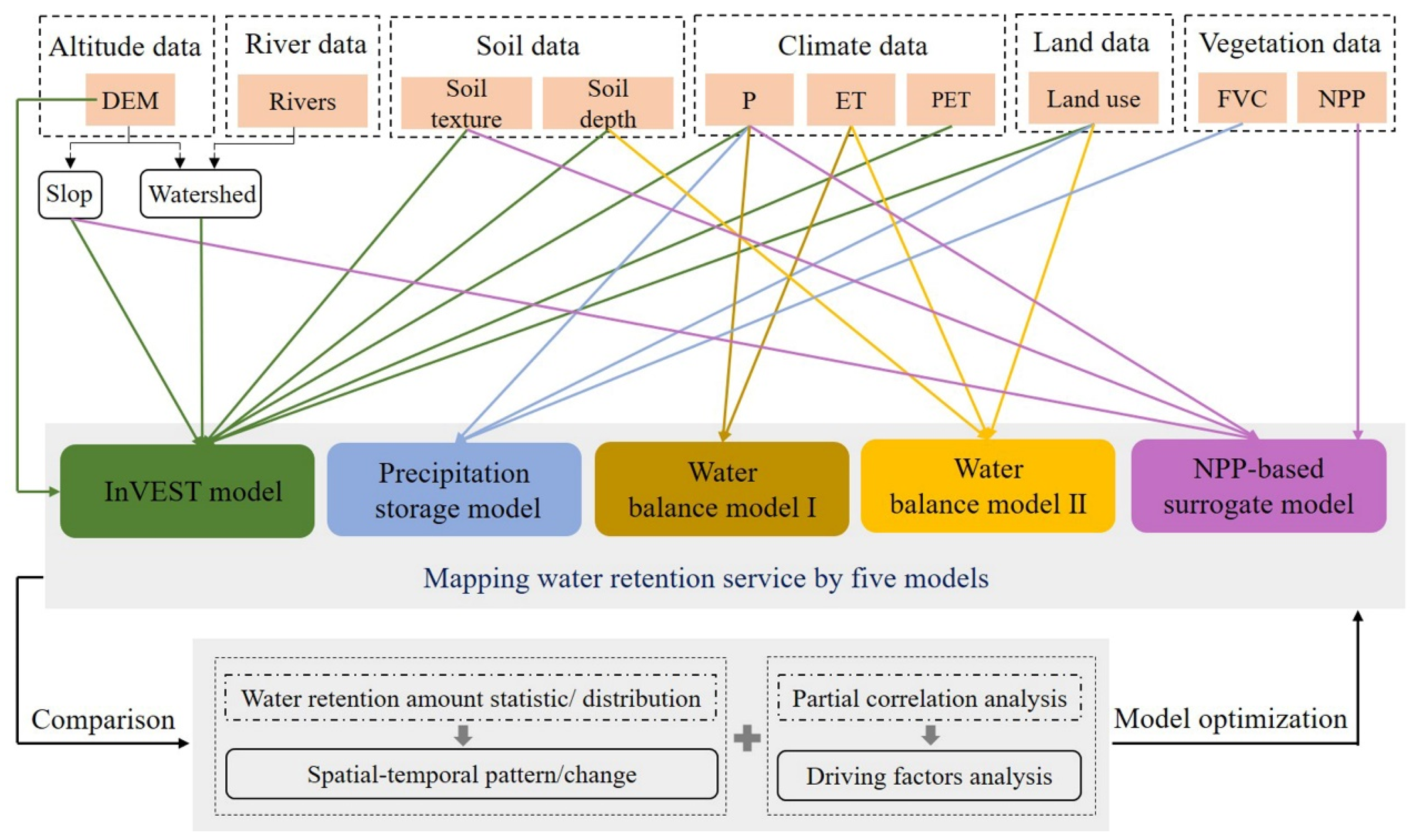

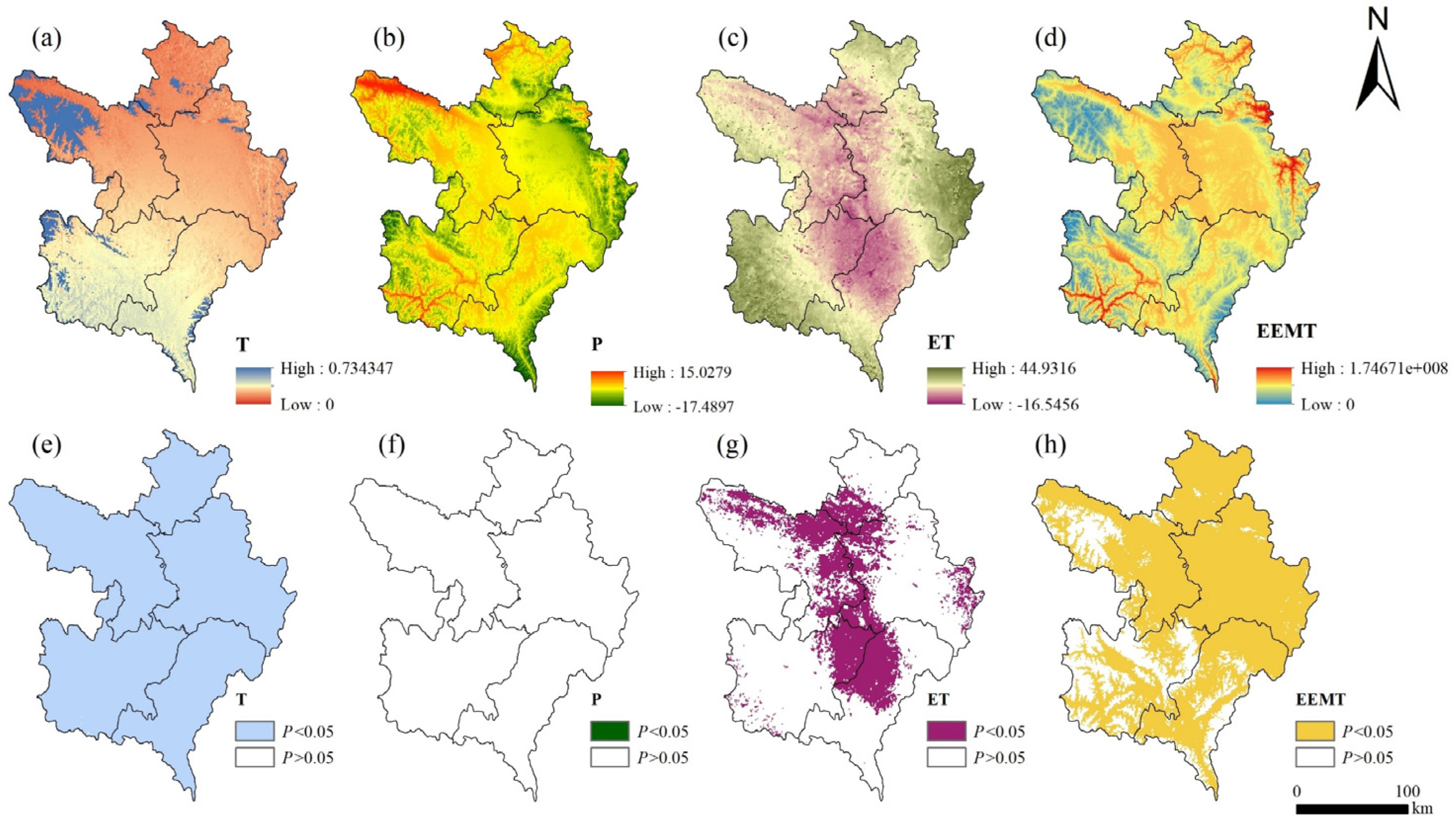


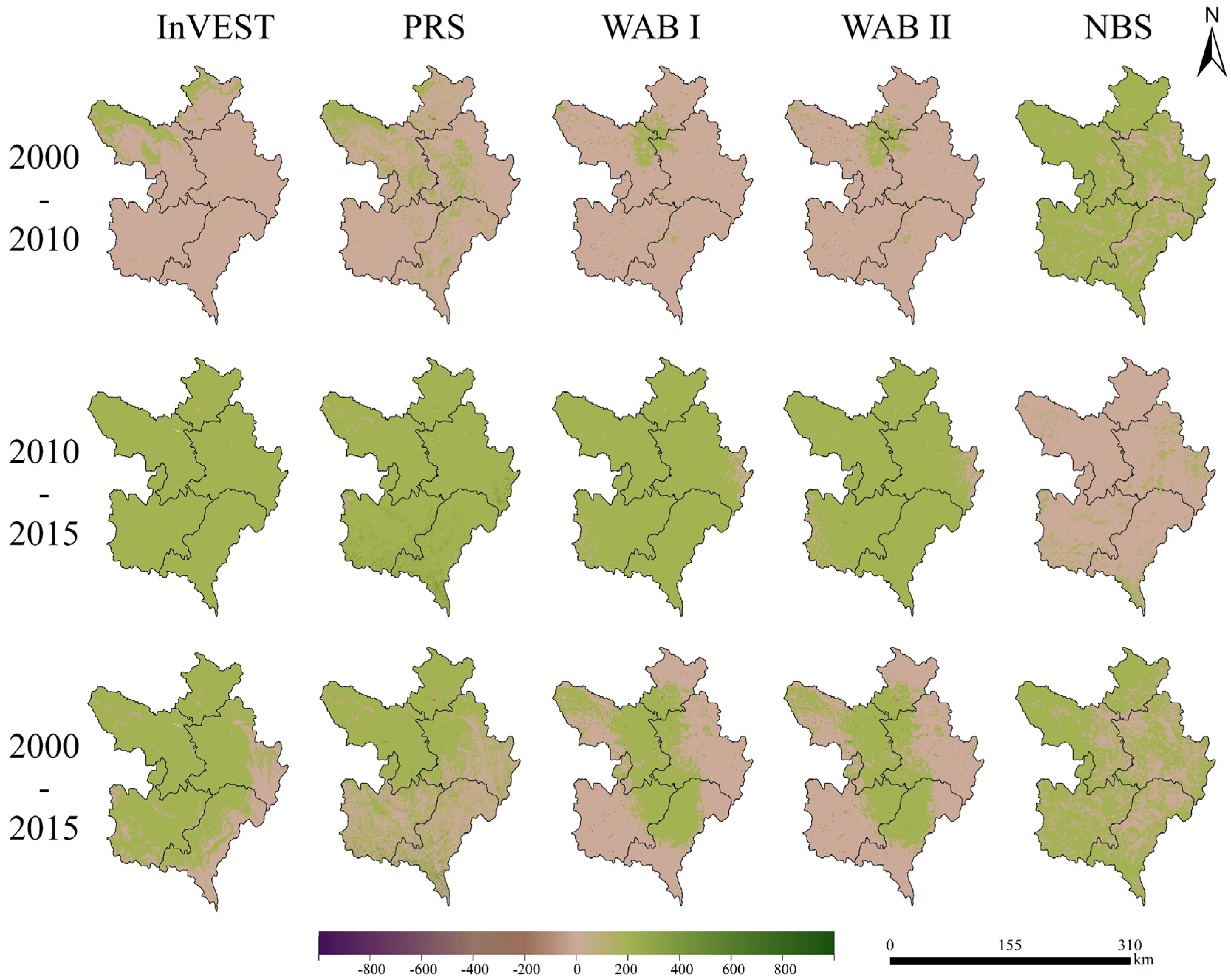
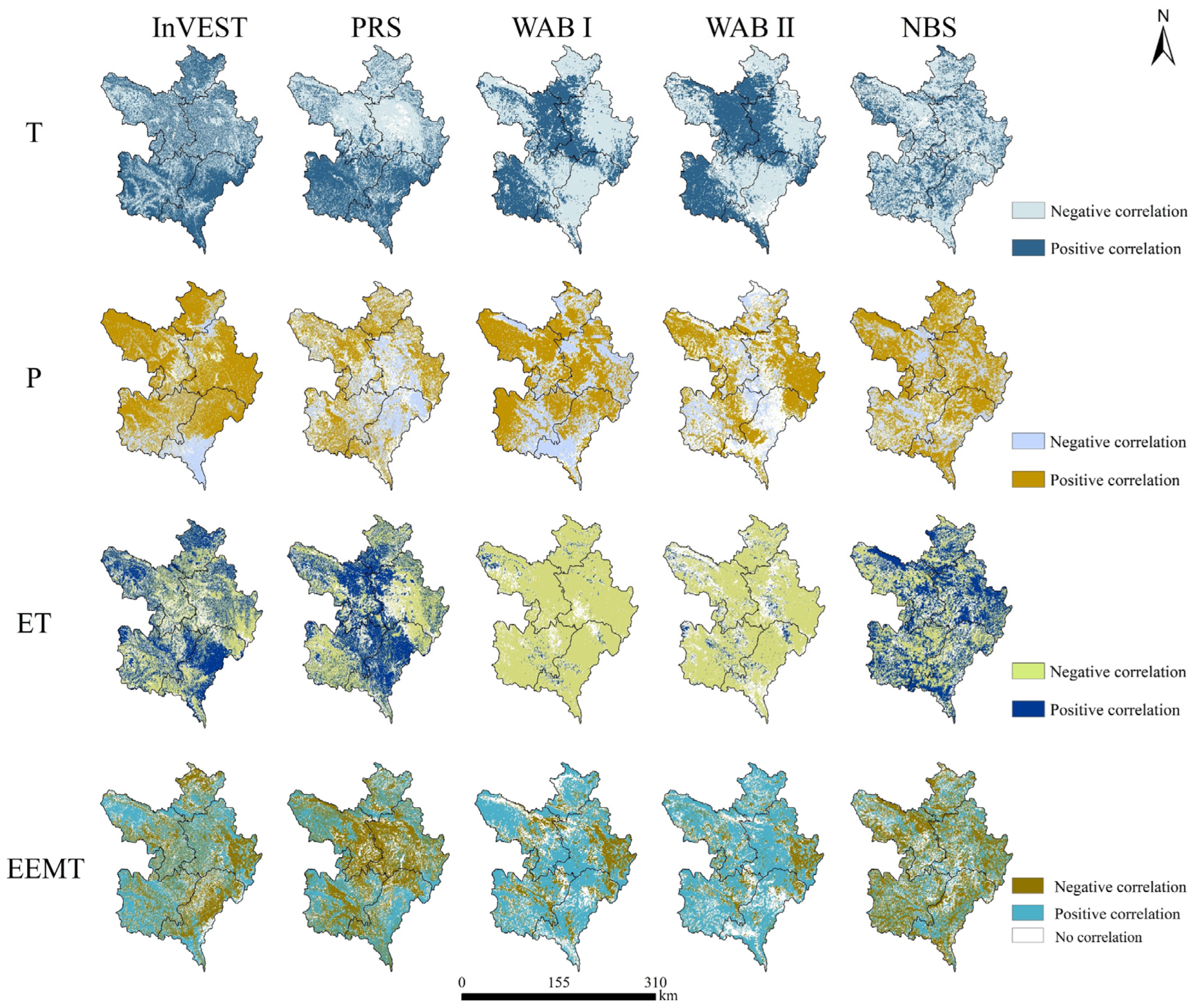
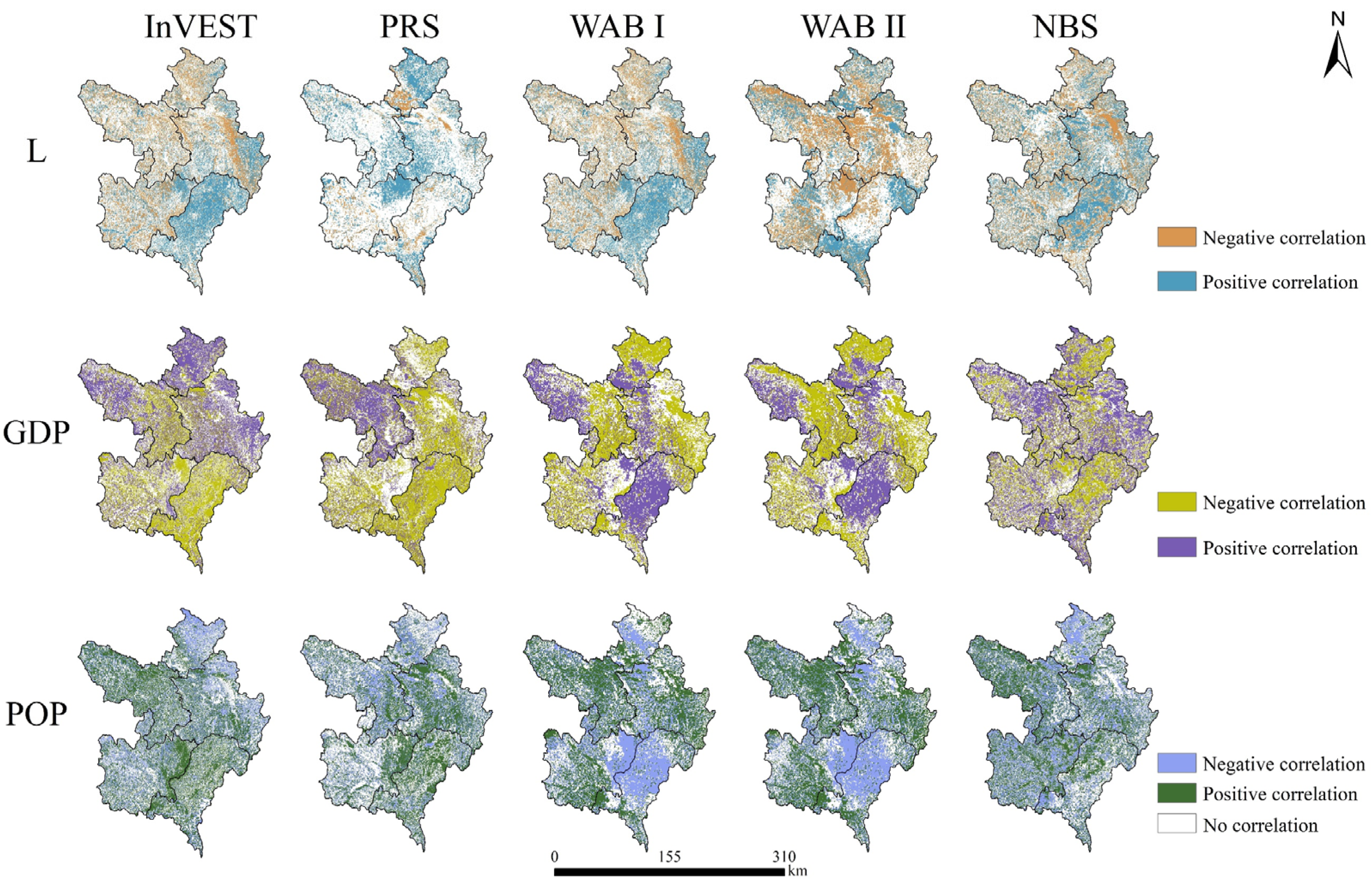
| Drivers | Temperature | Precipitation | Evapotranspiration | EEMT | Land Use Intensity | GDP | Population Density | ||||||||
|---|---|---|---|---|---|---|---|---|---|---|---|---|---|---|---|
| Models | Area (km2) | Percent (%) | Area (km2) | Percent (%) | Area (km2) | Percent (%) | Area (km2) | Percent (%) | Area (km2) | Percent (%) | Area (km2) | Percent (%) | Area (km2) | Percent (%) | |
| InVEST model | Positive | 24,294.96 | 56.88 | 28,149.75 | 65.90 | 17,523.39 | 41.03 | 18,773.75 | 43.95 | 11,741.67 | 27.49 | 15,585.16 | 36.49 | 16,831.87 | 39.41 |
| Negative | 14,935.75 | 34.97 | 9061.39 | 21.21 | 17,229.58 | 40.34 | 15,292.87 | 35.80 | 10,721.12 | 25.10 | 13,114.63 | 30.70 | 12,258.14 | 28.70 | |
| PRS model | Positive | 18,583.70 | 47.65 | 16,580.52 | 38.82 | 18,159.81 | 42.52 | 19,017.32 | 44.52 | 10,712.33 | 25.08 | 11,966.04 | 28.01 | 15,317.53 | 35.86 |
| Negative | 20,415.02 | 52.35 | 15,123.32 | 35.41 | 16,899.88 | 39.57 | 16,638.75 | 38.95 | 3728.08 | 8.73 | 16,747.22 | 39.21 | 12,381.78 | 28.99 | |
| WAB I model | Positive | 17,892.73 | 41.89 | 23,248.45 | 54.43 | 1155.51 | 2.71 | 24,399.69 | 57.12 | 9630.13 | 22.55 | 14,385.66 | 33.68 | 15,850.65 | 37.11 |
| Negative | 21,615.77 | 50.61 | 15,096.95 | 35.34 | 36,965.40 | 86.54 | 8498.39 | 19.90 | 11,715.66 | 27.43 | 14,524.02 | 34.00 | 15,063.18 | 35.27 | |
| WAB II model | Positive | 21,209.20 | 49.65 | 18,129.24 | 42.44 | 2259.73 | 5.29 | 26,194.72 | 61.33 | 10,960.71 | 25.66 | 13,685.20 | 32.04 | 16,223.72 | 37.98 |
| Negative | 16,417.89 | 38.44 | 9235.47 | 21.62 | 30,617.34 | 71.68 | 6485.74 | 15.18 | 13,304.71 | 31.15 | 15,789.56 | 36.97 | 15,458.57 | 36.19 | |
| NBS model | Positive | 14,348.02 | 33.59 | 23,972.37 | 56.12 | 18,703.74 | 43.79 | 13,826.34 | 32.37 | 13,210.07 | 30.93 | 17,309.52 | 40.52 | 15,799.46 | 36.99 |
| Negative | 19,906.80 | 46.61 | 12,246.80 | 28.67 | 16,416.53 | 38.43 | 18,614.40 | 43.58 | 11,656.09 | 27.29 | 12,045.92 | 28.20 | 15,446.70 | 36.16 | |
Publisher’s Note: MDPI stays neutral with regard to jurisdictional claims in published maps and institutional affiliations. |
© 2022 by the authors. Licensee MDPI, Basel, Switzerland. This article is an open access article distributed under the terms and conditions of the Creative Commons Attribution (CC BY) license (https://creativecommons.org/licenses/by/4.0/).
Share and Cite
Sun, M.; Hu, J.; Chen, X.; Lü, Y.; Yang, L. Comparison of Five Models for Estimating the Water Retention Service of a Typical Alpine Wetland Region in the Qinghai–Tibetan Plateau. Remote Sens. 2022, 14, 6306. https://doi.org/10.3390/rs14246306
Sun M, Hu J, Chen X, Lü Y, Yang L. Comparison of Five Models for Estimating the Water Retention Service of a Typical Alpine Wetland Region in the Qinghai–Tibetan Plateau. Remote Sensing. 2022; 14(24):6306. https://doi.org/10.3390/rs14246306
Chicago/Turabian StyleSun, Meiling, Jian Hu, Xueling Chen, Yihe Lü, and Lixue Yang. 2022. "Comparison of Five Models for Estimating the Water Retention Service of a Typical Alpine Wetland Region in the Qinghai–Tibetan Plateau" Remote Sensing 14, no. 24: 6306. https://doi.org/10.3390/rs14246306
APA StyleSun, M., Hu, J., Chen, X., Lü, Y., & Yang, L. (2022). Comparison of Five Models for Estimating the Water Retention Service of a Typical Alpine Wetland Region in the Qinghai–Tibetan Plateau. Remote Sensing, 14(24), 6306. https://doi.org/10.3390/rs14246306







